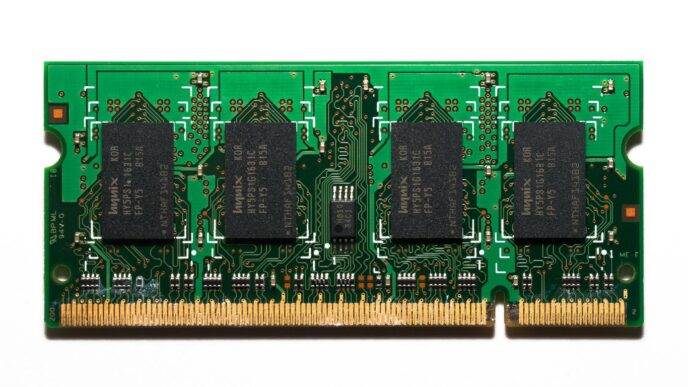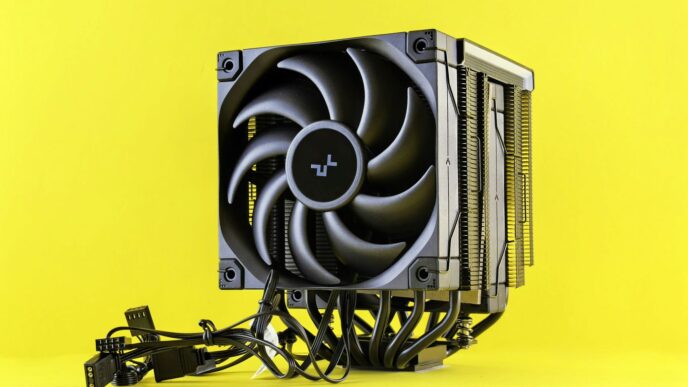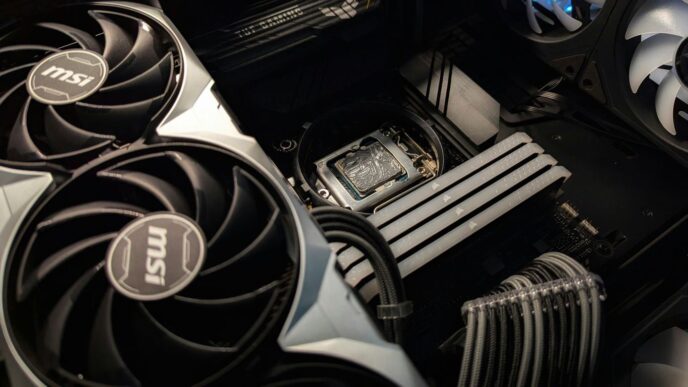Trying to pick the right processor for your PC build can feel like a puzzle, especially when you’re on a budget. The amd ryzen 3 vs intel i3 debate has been around for a while, and it’s still a hot topic for anyone looking for a capable chip without breaking the bank. We’re going to break down what these processors offer in 2025, looking at how they handle games, everyday tasks, and what you get for your money. Let’s see which one comes out on top for your next computer.
Key Takeaways
- When comparing the amd ryzen 3 vs intel i3, both offer decent performance for basic tasks and light gaming, but they have different strengths.
- Intel’s i3 processors often have an edge in single-core performance, which can be beneficial for older games and some applications.
- AMD’s Ryzen 3 processors, while sometimes a bit slower in single-core tasks, can offer more cores and threads, helping with multitasking and more modern games.
- Platform features like motherboard compatibility, PCIe support, and memory options (DDR4 vs. DDR5) can significantly influence your overall build cost and future upgrade potential.
- For budget builds in 2025, it’s important to look at the total system cost, including the motherboard and RAM, as well as the CPU’s performance in the tasks you care about most.
Understanding The Core Differences: AMD Ryzen 3 vs Intel i3
When you’re building a PC or just looking to upgrade, the processor, or CPU, is like the brain of your whole operation. It’s what makes everything happen. For budget builds, we’re usually looking at the AMD Ryzen 3 and Intel Core i3 lines. They’re designed to be affordable without completely sacrificing performance for everyday stuff and even some light gaming. But even though they’re both in the
Gaming Performance Showdown
So, you’re building a budget PC and want to know which CPU, the AMD Ryzen 3 or the Intel i3, will actually let you play your favorite games without pulling your hair out. It’s a fair question, and honestly, it’s where a lot of the budget CPU debate really heats up. We’re not talking about playing the latest AAA titles on ultra settings here, but getting a smooth, enjoyable experience in popular games.
Frame Rates in Popular Titles
When it comes to raw frame rates, both the Ryzen 3 and i3 lines can surprise you, especially in games that aren’t super demanding. We’ve seen some pretty competitive numbers, but AMD’s Ryzen 3 often edges out Intel’s i3 in many popular esports titles and older games, thanks to its typically stronger multi-core performance at this price point. This means smoother gameplay, especially when things get hectic on screen.
Here’s a general idea of what you might expect in some common scenarios (these are estimates, actual performance varies by game and settings):
| Game Title | AMD Ryzen 3 (Avg FPS) | Intel i3 (Avg FPS) |
|---|---|---|
| Valorant | 150+ | 140+ |
| CS:GO 2 | 120+ | 110+ |
| Fortnite (Medium) | 80+ | 75+ |
| GTA V (Low/Med) | 60+ | 55+ |
Impact of Clock Speed on Gaming
Clock speed is a big deal for gaming, no doubt about it. A higher clock speed generally means the CPU can process instructions faster, which directly translates to more frames per second. Intel’s i3 processors sometimes boast slightly higher boost clock speeds than their Ryzen 3 counterparts. This can give them an advantage in games that rely heavily on a single core’s performance. However, it’s not the whole story. AMD’s Ryzen CPUs often compensate with more cores or better architecture that handles multiple tasks more efficiently, which can be a bigger win overall for modern gaming.
Multi-threaded Gaming Scenarios
This is where things get interesting for budget builds. Many modern games are getting better at using multiple CPU cores. While an i3 might have a slight edge in single-core speed, a Ryzen 3 often has more cores or threads. This means it can handle the background tasks of gaming – like AI, physics, and network code – more smoothly without bogging down the main game thread. If you’re also running other things in the background, like Discord or a streaming app (even at a low quality), that extra multi-threading power from the Ryzen 3 can make a noticeable difference in keeping your game running smoothly.
Productivity and Everyday Tasks
When you’re not busy fragging noobs or editing videos, your PC still needs to handle the daily grind. This is where everyday tasks and productivity performance come into play. We’re talking about opening apps, browsing the web, managing emails, and maybe even some light document creation. So, how do the Ryzen 3 and i3 stacks up here?
Performance in Applications
For basic stuff like word processing, spreadsheets, and web browsing, both the AMD Ryzen 3 and Intel i3 processors generally do a fine job. You’re unlikely to notice a huge difference when just surfing the web or typing up a document. However, when you start opening multiple browser tabs, running background apps, or using more demanding software, the differences can become more apparent. Some applications are better optimized for certain architectures, meaning one might feel snappier than the other depending on what you’re running. It’s not always about raw speed; how the CPU handles different types of instructions matters.
Multitasking Capabilities
This is where things can get interesting. Multitasking, or doing several things at once, really puts a CPU to the test. If you’re the type of person who always has a dozen browser tabs open, music playing, and a chat app running in the background, you’ll want a CPU that can handle it without slowing down to a crawl. Processors with more cores and threads tend to handle multitasking better. For instance, Intel’s use of P-cores and E-cores can be beneficial here, with the E-cores handling background tasks efficiently. AMD’s approach with identical cores also offers strong multitasking, especially in their higher-core-count models. The ability to juggle multiple tasks smoothly is a big win for productivity.
Single-Threaded Performance Metrics
While multi-core performance is great for multitasking, many applications still rely heavily on single-core speed. This is often referred to as single-threaded performance. Think of it like a single lane on a highway – if that lane is slow, everything behind it gets held up, no matter how many other lanes there are. For tasks that aren’t designed to use multiple cores, a CPU with a higher clock speed or a more efficient core design for single tasks will perform better. This can impact things like the responsiveness of certain older applications or specific functions within software. You can check out some of the latest AMD Ryzen 9000 CPUs to see how they compare in various benchmarks.
Platform and Connectivity Features

When you’re putting together a new PC, or even thinking about an upgrade, the motherboard and its associated features are super important. It’s not just about the CPU socket; it’s about what the motherboard lets you connect and how fast those connections are. For budget builds like those featuring an AMD Ryzen 3 or Intel i3, this section is where you figure out what you’re getting into long-term.
Motherboard Socket Compatibility
This is the first hurdle. CPUs don’t just magically fit into any motherboard. They need a specific socket. For Intel, the current mainstream socket is LGA 1700, and for AMD, it’s AM5. Older platforms like AMD’s AM4 are still around, but they’re on their way out. Buying into an older socket might save you a bit upfront, but it severely limits your future CPU upgrade options. You can’t just assume a new CPU will fit an old motherboard, even if they’re from the same company. Always double-check the CPU support list on the motherboard manufacturer’s website. It’s a bit like trying to fit a square peg in a round hole if the socket doesn’t match.
PCIe and Storage Options
PCI Express (PCIe) is how your graphics card, SSDs, and other add-in cards talk to your CPU. Newer motherboards support faster PCIe versions, like PCIe 5.0, while older ones might be stuck at PCIe 4.0 or even 3.0. For budget CPUs, you’re likely looking at motherboards with PCIe 4.0 or 3.0. This is usually fine for most graphics cards and even fast NVMe SSDs. However, if you’re aiming for the absolute fastest storage speeds or a top-tier GPU down the line, a newer platform with PCIe 5.0 might be something to consider, though it’s often overkill for an i3 or Ryzen 3 build.
Here’s a quick look at common storage interfaces:
- NVMe SSDs: These connect via M.2 slots, usually using PCIe lanes. They’re way faster than older SATA SSDs.
- SATA SSDs/HDDs: These use the SATA interface, which is slower but still perfectly adequate for bulk storage or older drives.
- M.2 Slots: Motherboards have these slots for NVMe or sometimes SATA M.2 drives. Check how many your board has and what PCIe version they support.
DDR4 vs. DDR5 Memory Support
RAM is another big compatibility point. We’ve moved from DDR4 to DDR5. Motherboards are designed for one or the other; they aren’t interchangeable. DDR5 offers higher speeds and potentially better performance, but it’s also more expensive. For budget Ryzen 3 and Intel i3 builds in 2025, you’ll find motherboards supporting both. DDR4 is the more budget-friendly option and still offers plenty of performance for these entry-level CPUs. DDR5 might be a bit of a stretch for a strict budget build, but if you can find a good deal, it offers a more future-proof platform. Just remember, you can’t mix and match; you have to pick a motherboard that supports either DDR4 or DDR5 and buy the corresponding RAM.
- DDR4: Generally cheaper, widely available, and still very capable for budget systems.
- DDR5: Faster, newer, and more expensive. Offers better performance but comes at a higher cost.
- Compatibility: A motherboard will only support one type of DDR memory. Check the motherboard’s specifications carefully.
Power Consumption and Thermals
When you’re building a budget PC, keeping an eye on how much power your components draw and how much heat they put out is pretty important. It’s not just about the CPU itself, but also about what else you’ll need to buy to keep it all running smoothly. Think of it like this: a super powerful CPU might seem great, but if it needs a massive, expensive cooler and a beefy power supply, it kind of defeats the purpose of a budget build, right?
TDP Ratings and Real-World Usage
CPUs have something called a TDP, or Thermal Design Power. This is basically a guideline for how much heat the processor is expected to generate under normal use. For budget CPUs like the Ryzen 3 and Intel i3 lines, you’ll generally find lower TDP ratings compared to their higher-end siblings. This usually means they’re more energy-efficient and easier to cool.
- AMD Ryzen 3 CPUs often sit in the 35W to 65W TDP range, making them quite frugal.
- Intel Core i3 CPUs also typically fall within a similar 35W to 65W bracket, though some might push a bit higher under peak loads.
It’s worth noting that TDP isn’t the whole story. Under heavy load, like when you’re gaming or running demanding software, both chips can draw more power and produce more heat than their base TDP suggests. Intel’s chips, especially their higher-end models (though not usually the i3s), can sometimes have higher peak power draw figures, often referred to as Maximum Turbo Power (MTP).
Cooling Solutions and Requirements
Because budget CPUs generally run cooler, you often don’t need to go overboard with cooling. Most Ryzen 3 and Core i3 processors come with a stock cooler in the box. For everyday use and even moderate gaming, these stock coolers are usually adequate. They’re designed to keep the CPU within safe operating temperatures without costing you extra.
However, if you plan on pushing your CPU hard for extended periods, or if you live in a really warm environment, you might consider an aftermarket cooler. These aren’t usually super expensive for budget builds. A decent tower cooler can be picked up for around $20-$30 and will offer significantly better cooling performance and quieter operation than a stock cooler. This can help prevent thermal throttling, where the CPU slows itself down to avoid overheating.
Efficiency in Budget Builds
When you’re putting together a budget PC, efficiency really matters. A CPU that sips power not only generates less heat but also means you can get away with a less powerful (and cheaper) power supply unit (PSU). You also won’t need a motherboard with an overly robust power delivery system, which can also save you some cash. This focus on lower power draw is a big win for budget builders looking to keep overall system costs down. It means less money spent on electricity bills over time and a potentially quieter system because the fans don’t have to work as hard. So, while raw performance is important, don’t forget to factor in the power and cooling costs – they add up!
Value Proposition and Pricing
When you’re building a PC on a budget, the price tag is obviously a big deal. You want to get the most bang for your buck, right? That’s where the whole AMD Ryzen 3 versus Intel i3 debate really heats up. It’s not just about the upfront cost of the CPU itself, but also what motherboard you’ll need and if there are any hidden costs down the line.
Cost of CPU and Motherboard Bundles
Often, you can find some pretty good deals when you buy a CPU and motherboard together. These bundles can sometimes knock a bit off the total price, making it easier to fit both components into your budget. It’s worth checking out what’s available for both Ryzen 3 and i3 options, as sometimes one platform might have a better bundle deal going on at any given time. Keep an eye out for sales, especially around holidays or big shopping events.
Performance Per Dollar Analysis
This is where things get interesting. We’ve looked at how these CPUs perform in games and everyday tasks, but now we need to see how that performance stacks up against their cost. Generally, AMD’s Ryzen 3 processors have historically offered a strong performance-per-dollar ratio, especially in multi-core tasks. However, Intel’s i3 chips can sometimes be very competitive, particularly if you find them on sale or if their single-core performance gives you an edge in specific applications you use.
Here’s a rough idea of what you might expect, though prices fluctuate:
| CPU Series | Typical Price Range (2025) | Performance Tier | Value Notes |
|---|---|---|---|
| AMD Ryzen 3 | $100 – $150 | Entry-Level to Mid-Range | Often strong multi-core for the price |
| Intel Core i3 | $100 – $150 | Entry-Level to Mid-Range | Can offer good single-core speed, check for deals |
Long-Term Upgrade Paths
Think about where you might want to go in the future. If you buy an AMD Ryzen 3 on an AM4 motherboard, for example, you might have a decent upgrade path to a more powerful Ryzen 5 or even Ryzen 7 from a previous generation without needing a new motherboard. Intel’s platforms can sometimes be a bit more restrictive. While you might get a good deal now, you could find yourself needing a new motherboard sooner if you want to upgrade your CPU down the line. It’s a trade-off between initial cost and future flexibility.
So, Which Budget CPU Wins?
Alright, so we’ve looked at the AMD Ryzen 3 and Intel i3 options for budget builds in 2025. Honestly, it’s not a clear-cut win for either side. Intel’s i3 often brings a bit more to the table for everyday tasks and general use, especially if you can snag a good deal. But AMD’s Ryzen chips, even the lower-end ones, tend to offer a bit more flexibility and sometimes better gaming performance for the money, especially if you’re thinking about upgrading later. It really comes down to what you’ll be doing most. If it’s just web browsing and office work, either will do fine. If you want to squeeze in some gaming without breaking the bank, keep an eye on those Ryzen deals. Make sure to check current prices because that can really swing the decision.
Frequently Asked Questions
What’s the main difference between AMD Ryzen 3 and Intel i3 processors?
Think of processors like the brains of a computer. AMD Ryzen 3 and Intel i3 are like two different brands of smaller brains, designed for less expensive computers. They both handle basic tasks well, but they’re built a little differently inside, which can make one slightly better than the other for certain things like gaming or running lots of apps at once.
Are Ryzen 3 and i3 processors good for gaming?
Yes, for budget gaming, they can be! These processors are good for playing many popular games, especially if you’re not aiming for the absolute highest graphics settings. They work best when paired with a decent graphics card. For really demanding games, you might need a more powerful processor, but for casual gaming, they’re a solid choice.
Can I use Ryzen 3 and i3 processors for school or work tasks?
Absolutely! For everyday tasks like writing papers, browsing the web, watching videos, or using office software, both Ryzen 3 and i3 processors are perfectly capable. They handle these kinds of jobs smoothly without any problems.
Which one is faster, AMD Ryzen 3 or Intel i3?
It really depends on the specific models you’re comparing and what you’re doing. Sometimes the Intel i3 might be a bit quicker in certain tasks, while other times the AMD Ryzen 3 could have the edge. It’s like comparing two similar-sized race cars; they might perform differently on different tracks.
Do I need a special cooling fan for these processors?
Most of the time, the processors come with a basic cooler that’s good enough for normal use. However, if you plan on pushing your computer hard, like during long gaming sessions, a better cooling fan can help keep things from getting too hot and running slower.
Are Ryzen 3 and i3 processors expensive?
No, these are considered budget-friendly options. They are designed for people who want a good computer without spending a lot of money. You can often find great deals on computers or parts that use these processors.














